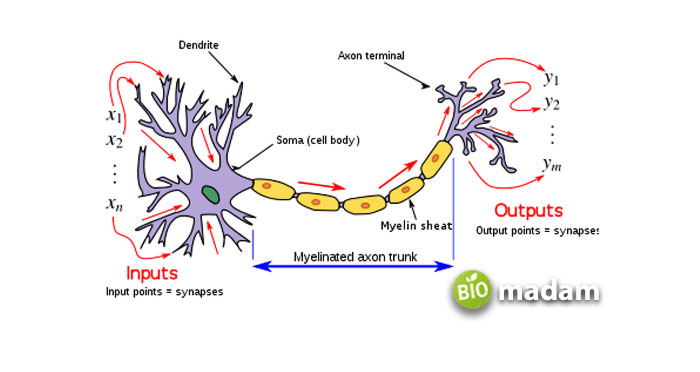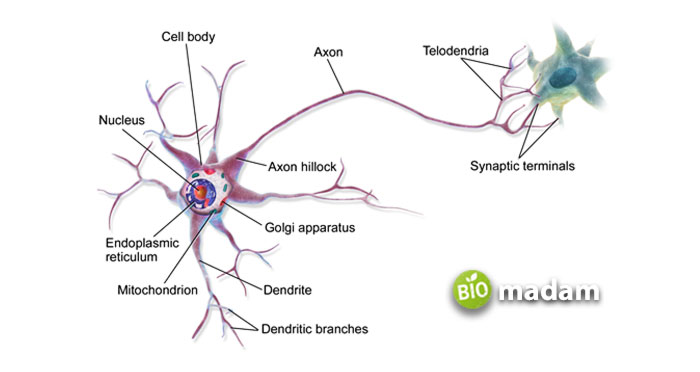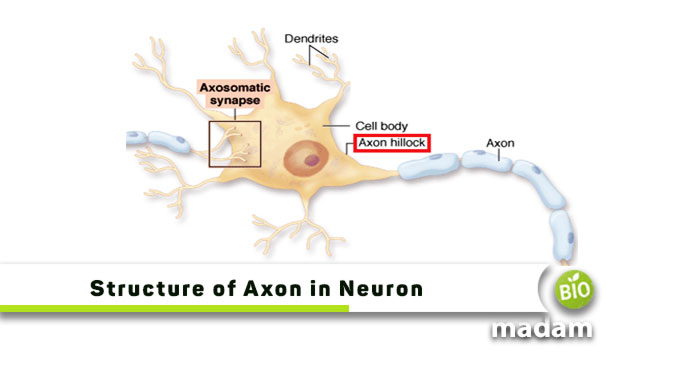The role of the brain, spinal cord, and neurons are well-known for coordinating functions within the body. However, their mechanism of action plays a major role in understanding how the neurons produce action. Understanding the unique function of axons in the neurons has helped researchers understand the nervous system. It allows for better identification and treatment of brain-related diseases.
What is an Axon?
Axons, also known as the cable transmission of neurons, comprise the long body of a neural cell. Each neuron has one long, thin, cable-like structure extending away from the cell’s main part. This cable-like long axon part is thinner than human hair and helps transmit electrical impulses. The axons in neurons have the same structure but may vary in length. The size of the length of the neurons depends on the type of neurons. Some are a few millimeters, while a few may be over one meter in length.
Axons may have a fatty covering on their outside called myelin. The same fatty material constitutes the brain’s white matter. It provides insulation to axons and allows them to send signals to distant areas. The axons have side branches known as axon collaterals to connect one neuron to the other. These axon collaterals further extend and form terminal branches with synaptic terminals on their tips.
The communication between neurons is facilitated through the action of axons and dendrites. The process occurs through synapses between the dendrites on one end and the axon terminals on the other. The electrical signals between the axons and dendrites move through the 20 – 40 nm gap. Neurotransmitters transfer these electrical signals from one neuron to the other.

Function of Axon in Neuron
The main function of the axon in a neuron is the transport of impulses from one end to the other. Axons from motor neurons may carry information regarding the movement of a muscle or to stop movement. They carry that information to the dendrite of the next neuron to act. The muscle tissues will perform the function as directed by the nerve impulse. The action of the axons and dendrites is not only restricted to muscles, instead, all functions in tissues and organs take place by the nerve impulses generated in response to a stimulus.
The axonal transport may be retrograde or anterograde depending on the direction of the transport. Retrograde transport carries waste products from the axon terminal toward the neuron body for processing. At the same time, anterograde is the movement of waste materials like neurotransmitters or mitochondria toward the axon of the cell body. Retrograde movement involves dynein, whereas anterograde movement makes use of kinesin.
The cytoplasm of the axon is known as an axoplasm that contains neurofilaments and microtubules. These components of the axon structure enable retrograde or anterograde movement of the waste materials.

Axons and Nerve Degeneration
Axons are critical to the function and structure of nerves. Thus, the neurons cannot function and communicate properly if the axons are damaged. It typically occurs due to neurodegenerative diseases such as Parkinson’s and Alzheimer’s. Other possible causes may include motor neuron conditions or neuron diseases. Research shows that the gene mec-17 stabilizes the internal neuronal structure and facilitates the transport of nerve impulses within the axon. Mutations in the mec-17 may lead to malfunctions and damage the axons. The damaged axon signals the surrounding tissue, asking for apoptosis. The neighboring cells release proteins that degrade the axon. Medical advances restricting the activity of these apoptotic proteins may help prevent nerve degeneration. Some neurons also indicate the cells to save them by building a bridge to mend the axon. Understanding this process has helped researchers and scientists to understand the mechanism of action and prevent serious nerve injuries in the future.
The Bottom Line
Axons are an important part of the nervous system and contribute to transferring nerve impulses from one neuron to the other. The axon is the longer part of the neuron, which branches at the end. They communicate with neighboring cells through neurotransmitters to facilitate actions within the body. Changes in the structure of the axon can lead to cell death and degenerate the nerves, leading to various neural diseases and disorders.
FAQs
What is the importance of axons?
Axons are primarily responsible for carrying electric impulses and facilitating communication between the brain and the rest of the body.
What are 4 differences between axons and dendrites?
Axons and dendrites are two ends of a neuron. Axons are long, unbranched, untapered, and presynaptic parts of the neuron. At the same time, dendrites are tapered, branched, short, and postsynaptic.
What is the main function of axon endings?
The axon endings are specialized parts of the neurons that release neurotransmitters into the synapsis in response to a stimulus carried by the axon body.
What are the two types of axons?
Axons are of two types: myelinated and nonmyelinated. Myelinated axons have a white myelin sheath covering, while the nonmyelinated axons have Schwann cells and neurilemmal.
Do axons send or receive?
Axons transmit messages from the cell body to the dendrites of other neurons in the nervous system through neurotransmitters. They help nerve signals travel to far-off tissues through communication with other cells.
Are axons thinner than dendrites?
Axons are thinner than dendrites and, thus, are difficult to find and study. Understanding the neighboring branches can help identify if you are looking at an axon or dendrites.
How many axons are there?
Research shows 6,200 axons between the cortical areas in the hemisphere. At the same time, 1,300 axons are present interhemispherically.
Which neuron has two axons?
Pseudounipolar neurons extend from the cell body, split into two axons towards the end, and form dendrites.

Hello, I would like to introduce myself to you! I am Chelsea Rogers, an experienced blog writer for science articles, holding an MPhil degree. My enthusiasm to grab the best knowledge, let it relate to botany, zoology, or any other science branch. Read my articles & let me wait for your words s in the comment section.

